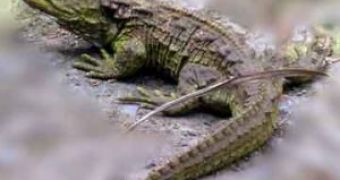One degree Celsius (1.8 degrees Fahrenheit) more on the average temperature of New Zealand and the tuatara, a "living fossil" reptile, will be gone.
This species belong to a family and a group that evolved 200 million years ago at the beginning of the dinosaur era.
As in many reptiles, like crocodiles and turtles, the sex of the young tuatara is temperature induced: at higher temperature, there will be more male hatchlings.
This physiology is so sensitive, that an already endangered population on North Brother Island in Cook Strait is running short of breeding females due to global warming.
"At 22 degrees Celsius [71.6 degrees Fahrenheit], we got 100 percent males. At 21 degrees Celsius [69.8 degrees Fahrenheit], we got three males out of 80 eggs," said Nicky Nelson, a senior lecturer at Victoria University in Wellington, New Zealand, who points that 21.7 degrees Celsius are the optimum point.
On other reptiles with gender determined by temperature, this point is much higher.
The problem aggravates considering the very few breeding populations and the slow reproduction rate of tuatara. Tuatara females mate once every four years, and the eggs hatch after 11 to 16 months.
These reptiles were already a kind of "living fossil" when dinosaurs vanished but they resisted to dinosaur extinction. During those times, the species had enough genetic diversity to endure the global catastrophe, but now, with their numbers already decimated, the species faces a more rapid rate of warming.
"These creatures can live for more than a hundred years. We're talking perhaps a 5-degree jump in a single animal's lifetime," Nelson said.
"We're not talking adaptation-we're talking about the abilities of individuals to survive."
Once, tuatara lived throughout New Zealand, but the introduction of rats, cats, and stoat by humans restricted their habitat to remote, small islands.
"On North Brother, most nesting is in very shallow soil, and there's already a male bias in the population," Nelson said. "There's probably no way to naturally resurrect that."
So the biologists gather eggs from the wild and incubate them artificially.
"We can dial in whichever sex we like," Nelson said.
Captivity reared young tuatara are released to remote islands as part of an effort to enlarge and reintroduce the tuatara to more zones, increasing its probability of surviving.
But "there are the potential impacts of rising sea levels, coastal erosion, and habitat loss in general," warns Alison Cree, a senior lecturer at the University of Otago in Dunedin, New Zealand.
Scientists want to make a tuatara reserve protected by a special fence against predators at Orokonui, near Dunedin, more southern than the current distribution of the reptile, in order to save time for the species as northern New Zealand will be more impacted by warming climate in this century.
"Eight populations of northern tuatara live on islands of 5 hectares [12 acres] or smaller, often with only two or three hectares [5 or 7 acres] of suitable habitat," she said.
"The higher the sea level, the smaller that will get. We're already concerned about the long term future of those populations-there are so few animals there already."

 14 DAY TRIAL //
14 DAY TRIAL //